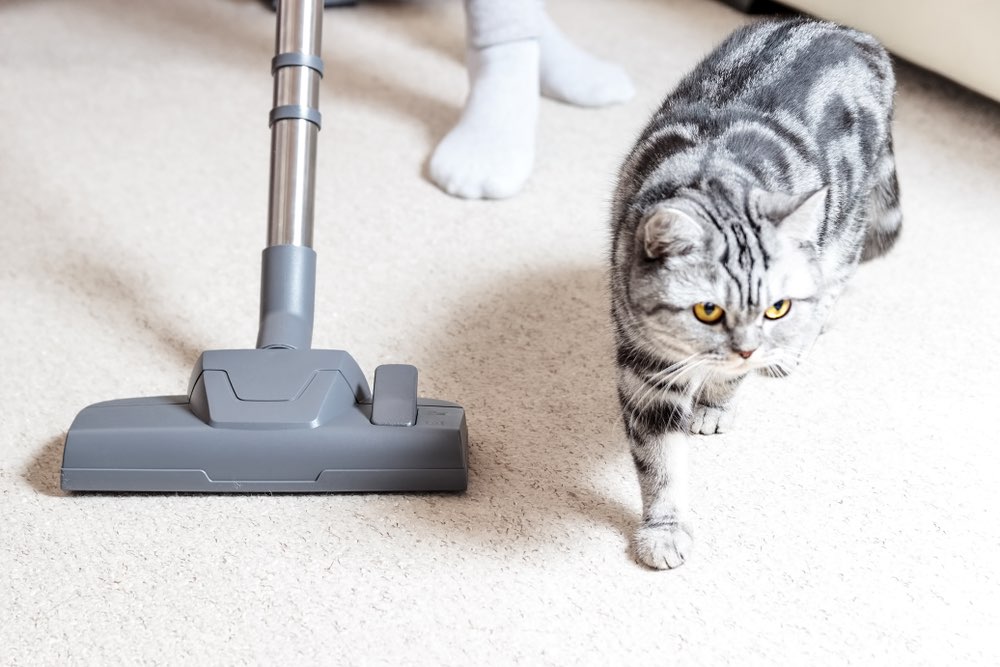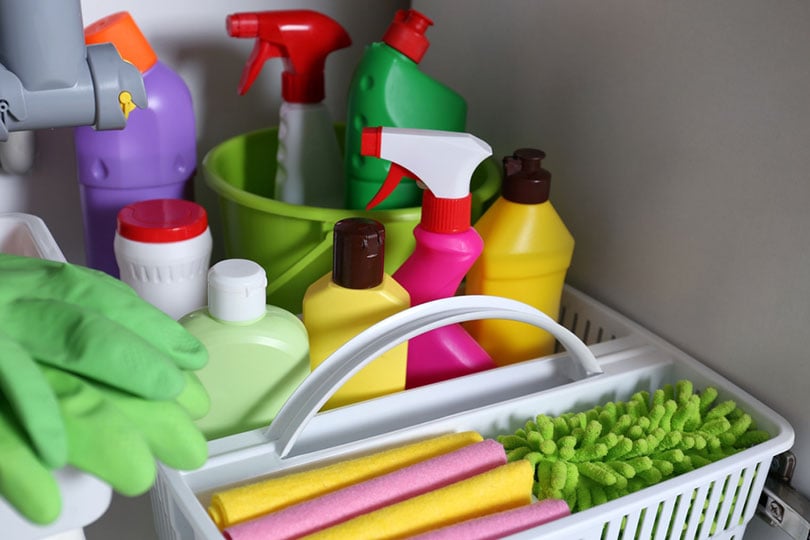26 Tips for Apartment Living With Cats (2024 Guide)

Updated on

Cats are often better apartment pets than dogs due to requiring less space and having lower exercise needs. If you’re interested in bringing a cat into your apartment, welcome to the ultimate guide for making your apartment a cat-friendly haven! From finding the perfect spot for the litter box to ensuring their mental stimulation, we’ve got you covered with several essential tips. Let’s dive in and explore how you can transform your living space into a feline paradise.
The 26 Tips for Apartment Living With Cats
1. Find the Perfect Place for Your Cat’s Litter Box
Selecting an ideal location for your cat’s litter box is crucial in an apartment setting. It should be quiet, accessible, and distinct from their feeding area. Cats prefer to do their business in a secluded spot. The litter box should be away from busy areas to prevent startling your cat. Cats also don’t like to eat near their toilet, and neither would you, so make sure you keep their food and water bowls away from the litter box.

2. Hide the Litter Box in Plain Sight
To maximize space in your apartment, consider clever ways to disguise your cat’s litter box. A litter box cabinet can double as a functional piece of furniture. Not only will it store your cat’s supplies, but it also offers them a secure space for their business. Most litter box cabinets come with extra shelves to save you room.
You can also tuck the litter box in a closet or under a bathroom sink. A decorative screen can hide the box while allowing your cat easy access.
3. Clean the Litter Box Daily
Maintaining the cleanliness of the litter box is essential to prevent odor buildup and ensure your cat’s comfort. Make it a habit to remove waste every day. Deep clean the box with mild detergent weekly. Old litter can harbor bacteria, so change it frequently.
4. Provide Scratching Objects
Protect your furniture by offering your cat plenty of scratching options. Offer different types of scratchers—vertical, horizontal, cardboard, sisal. Place scratchers near furniture pieces your cat may be tempted to scratch. You can also make scratchers more appealing by sprinkling them with catnip.
5. Use Toys That Engage Your Cat
Toys play a vital role in keeping your cat entertained and physically active in an apartment. Toys that move or make noise can engage your cat’s attention. Puzzle toys stimulate your cat’s mind and are perfect for food-motivated cats, as your cat has to figure out how to get the food or treats out. Keep your cat’s interest by rotating the toys every few days.
6. Think Vertically
Many apartments are notorious for not having enough space. But cats love to climb. Utilize vertical spaces in your apartment to satisfy this instinct. Wall-mounted shelves can create a vertical playground for your cat. Cat trees offer a great climbing outlet and come in various sizes. Window perches provide an elevated view for your indoor cat. If your cat likes to jump on furniture that can topple over easily, make sure the furniture is securely attached to the wall.
7. Deck Out Windowsills
Cats love observing the world outside. Make windowsills more cat-friendly. Make the sill comfortable with a plush cushion or cat bed. Ensure the window has a secure screen if you choose to open it up for fresh air, so your cat can’t escape. Install a bird feeder outside the window for live entertainment.

8. Get the Right Plants
Some houseplants can be harmful to cats. Make sure to fill your apartment with cat-friendly greenery. Many common houseplants are toxic to cats. Cat grass is safe for cats and satisfies their urge to nibble on greens. Ensure plants are secure and won’t tip over if your cat brushes against them.
9. Schedule Play Sessions
Have set playtimes to help your cat burn off energy. Experiment with different toys to find out what your cat likes. Make time to play with your cat, not just leave them to play alone. Mix up the time of day and duration of your play sessions. This keeps your cat’s interest piqued. Offer treats after playtime to reinforce positive behavior.

10. Choose the Right Food
Providing nutritious, high-quality cat food contributes to your cat’s overall health and well-being. Kittens, adults, and seniors all have different nutritional needs. When deciding between wet and dry food, both types have their pros and cons. Many cat owners offer a mix of both. All that matters is that you look for foods with high-quality, specific animal proteins listed as the first ingredients.
11. Provide Fresh Water Always
Hydration is key to your cat’s health. Ensure fresh water is always available. Having several water bowls around can encourage your cat to drink more. Many cats prefer running water and may drink more with a fountain. To ensure freshness, clean water bowls daily.

12. Regular Vet Check-ups
Regular vet visits are crucial for keeping your cat healthy. Annual exams can catch potential health issues early. Protect your cat from preventable diseases by keeping up with vaccinations, especially in the event that they do sneak outside. Ask your vet about dental cleanings and how to brush your cat’s teeth at home.
13. Groom Your Cat Regularly
Regular grooming helps keep your cat clean, reduces shedding, and can be a bonding activity. Regular brushing can reduce hairballs and shedding. Keeping nails trimmed can prevent destructive scratching. Most cats self-clean, but occasional baths may be necessary for some cats with long coats.

14. Train Your Cat
Training cats can be harder than training dogs, but training can help manage behavior issues and stimulate your cat’s mind. The clicker training method can be a fun and effective way to teach your cat commands and tricks. Always reward good behavior with treats or praise. And remember, training takes time and consistency.
15. Provide a Safe Outdoor Space
If possible, provide a secure outdoor space for your cat to explore. This can help provide them with extra stimulation and keep them from getting bored. Consider creating a catio or secure enclosure on your balcony. Window boxes can provide fresh air and a view while keeping your cat safe. With patience, you can also train your cat to walk on a harness for outdoor adventures or get a backpack that allows you to carry your cat with you to go on walks or hikes.

16. Secure Windows and Balconies
Safety is paramount, especially in high-rise apartments. Make sure all windows and balconies are secure. Use pet netting or a balcony enclosure to keep your cat safe. Never let your cat on a balcony unsupervised.
17. Consider a Companion
If you’re away often and you have the space, consider getting a second cat for companionship. Try to choose a companion with a similar personality and energy level. Introduce new pets slowly and in a controlled environment. Two kittens may get along better than introducing a kitten to an older cat. Just remember that double the cats means double the supplies, including at least one extra litter box (cats don’t like to share). Make sure you have plenty of room to accommodate two cats.

18. Provide Hideouts
Cats need their own safe spaces where they can retreat when they want to be alone. Never underestimate the appeal of a simple cardboard box. Cat tents or tunnels can provide a fun and secure hideaway. Spaces under beds or sofas provide areas for your cat to retreat to, provided that they can get in and out easily.
19. Control Allergens
Managing allergens such as dust, hair, and dander is key to maintaining a comfortable living environment in an apartment. Vacuum and dust regularly to keep allergens down. Air purifiers can help remove pet dander from the air. Consider choosing bedding and furniture made from hypoallergenic materials.

20. Manage Noise
Loud noises can stress cats. Try to keep noise levels down in your apartment, especially when you’re away. Choose appliances that operate quietly. White noise machines can help drown out traffic or other noises from outside your apartment. Some cats find soft music or nature sounds soothing.
21. Maintain a Consistent Routine
Cats are creatures of habit. Keeping a consistent routine can make them feel secure. Try to feed your cat at the same times each day. Regular play sessions can help your cat burn energy and reduce stress. A consistent bedtime routine can help your cat sleep through the night.

22. Monitor Indoor Temperature
Ensuring your apartment temperature is comfortable for your cat is particularly important during extreme weather conditions. Make sure your cat’s favorite spots are free from drafts. In cold weather, provide warm beds or blankets. In hot weather, ensure your apartment is well-ventilated and not too hot.
23. Keep Toxic Materials Secure
Ensuring your apartment is free from substances that can be toxic to cats is a must. Keep all cleaning supplies stored away and out of reach. Check to make sure any plants you have are not toxic to cats. Avoid using certain types of air fresheners, essential oils, or other strong chemicals that can be hazardous to cats if inhaled.

24. Watch for Changes in Behavior
Cats communicate through behavior. Watch for any changes as these could indicate stress or health issues. Changes in appetite can indicate health problems. If your cat stops eating, visit your vet. Overeating can lead to obesity, which is associated with a host of health problems. Problems with using the litter box can also signal health issues. Note changes in activity levels, which can also indicate stress or illness.
25. Keep Them Stimulated and Safe While You’re Away
If you’re out for long hours for work or for a day trip, ensure your cat has plenty of stimulation at home. Make sure your cat has plenty of toys to play with. Some cats enjoy watching nature programs, so consider leaving the TV on. If nothing else, the TV can create background noise to distract your cat or make them seem like they aren’t alone. You also might want to consider a pet camera, which lets you watch and interact with your cat remotely.

26. Love and Patience
Building a strong bond with your cat takes time, love, and patience. Enjoy every moment of the journey. Trust takes time to build. Respect your cat’s boundaries. Rewards and treats can help build trust. Talking to them in a soothing voice can help create a strong bond. Spend quality time with your cat when you’re home, engaging in activities like playing, grooming, or just cuddling up together. Regular affection can help bond you to your cat. Finally, cats are wonderful companions—cherish every moment with them.
Final Thoughts
And there you have it – a comprehensive guide to creating a cat-friendly apartment. Remember, the key to a happy cat is a safe, stimulating, and comfortable environment. With these tips, you’re well on your way to becoming the purr-fect cat parent. So, let’s get started on making your apartment a kitty utopia today!
Featured Image Credit: Nata Bene, Shutterstock










